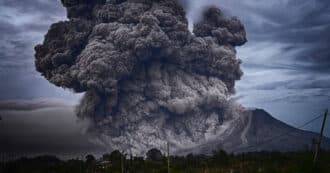By Jordan Rindler
Locusts and Cicadas seem to be very similar insects: they’re both known for their enormous numbers, they both feast on vegetation, and they do look similar to an untrained eye.
In fact, they are entirely different species!
Locust
Locusts belong to a species of grasshopper that, under the right environmental conditions, relinquishes its solitary nature and becomes gregarious.
There is no taxonomical difference between grasshoppers and locusts, but of the 7,000 species of grasshoppers, a small minority of them exhibit the swarming behavior that differentiates the two.
Disasters Caused by Locusts
Locust swarms have become natural disasters in much of Africa, Asia, and Australia for centuries.
Most locust species live in Africa and the Middle East, in very arid climates.
However, after a heavy rainfall season locusts are able to lay their eggs in the moist soil in large numbers. Vegetation in the desert also thrives off a wet season, leading to young locusts having plenty of food to devour.
Strength in Numbers: Locust Swarms
These conditions form a locust swarm, where thousands of locusts lay millions of eggs that eventually result in a swarm of billions.
These locusts fly across continents looking for their next meal, often with such great population density that they obscure the sunlight.
Locust swarms are absolutely devastating to agricultural communities. Entire fields of crops and months of investment can be consumed overnight, before farmers are even aware of what is happening.
Famine, poverty, and economic instability are usually left in the wake of these disasters.
The Role of Climate Change in Locust Breeding
An excerpt from the Eco Bible reads:
“In 2020, the largest locust swarms in more than 50 years spread from Kenya to Iran and impacted tens of millions of subsistence farmers. An article in Nature noted how one swarm in Kenya had tens of billions of locusts and was three times the size of New York City.”
Journalist Bob Berwyn explains the role of climate change:
“Warm weather and heavy rains at the end of 2019 set up a perfect storm of breeding conditions for the destructive bugs . . . Changes in plant growth caused by higher carbon dioxide levels … can lead to more prolific and unpredictable locust swarming”.
Human Retaliation on Locusts
The war waged on all agricultural pests from weeds to blight to insects has not ignored the potential devastation of locust swarms.
Chemical pesticides and other effective methods of insect control have reduced the plague of these swarms in developed nations that can afford these advancements.
However, developing countries in Africa and parts of Asia are still just as vulnerable to these pests as the Egyptians were in the times of Exodus.
Locusts as Biblical Pests
Locusts have been associated with disasters for thousands of years. In the bible, locusts are one of the plagues brought on Egypt, by Moses, in order to free the Israelite slaves.
Locusts are also found in the Qur’an in Sura 7:138.
Locust plagues in China are mentioned in ancient Chinese texts, such as the “Zuo Zhuan”, one of the first pieces of literature produced by the Chinese empire during the Zhou Dynasty.
The reference to locusts in religious and cultural texts in early human civilization shows just how prevalent and dangerous locust swarms have been since humans became dependent on agriculture for their sustenance.
Locusts As A Bad Omen
Locust swarms devastate agricultural land and eat crops that otherwise would have been used for food.
These swarms represent uncontrolled reproduction without social structures, so they appear chaotic, cause confusion, and feed on vegetation indiscriminately.
Locusts as an Emergency Food Source
Interestingly, locusts are the only insect that is considered Kosher in Judaism. This stems from the fact that when a locust swarm consumes all the vegetation in the land, it becomes one of the only sources of nutrition remaining for the affected region.
In times of famine, Kosher laws are put to the side and survival becomes a priority again!
Cicada
Cicadas are an entirely different type of insect. The cicada family can be separated into two categories, periodical and non-periodical.
The non-periodical cicada species behave similarly to other winged insects, feeding on leaves for a majority of their 1-3 year life cycle.
The periodic cicadas, however, are found exclusively in North America, and fill an extremely specific niche in the insect world.
Periodic Cicadas
These 7 species of periodic cicadas have one of the most unique life cycles of any member of the animal kingdom, shown below:
- Cicada eggs are laid in the stem of woody plants.
- Once the eggs hatch, cicada nymphs drop to the ground and begin burrowing into the soil.
- These nymphs go through their entire juvenile lives underground, feeding on a fluid found in tree roots.
- After 13 or 17 years the now-mature cicadas are ready to emerge, in spring.
- The synchronized emergence of millions of Cicadas is triggered when the soil temperature reaches a critical value, releasing a chemical signal to the Cicadas causing them to dig upwards and see the surface for the first time in their 17 years of life.
- The following 4-6 weeks, Cicadas begin their mating cycle. Males produce a symphony of buzzing sounds by rubbing their clear wings together, while females click with their hind legs to reciprocate interest.
- Females lay their eggs in the same trees where they were born, die, and the cycle repeats itself.
Cicada Versus Locust
When we understand the differences between cicadas and locusts, we can better appreciate how these different insects shape their environment.
Locusts pose a threat to farmers and human communities through their ravenous appetite for any vegetation they can get their mandibles on, while cicadas not only spend most of their life underground but also avoid interaction with humankind.
Both insects serve as a feast for their local ecological communities, propping up the ecosystem with near-endless protein snacks.
* Featured image source




